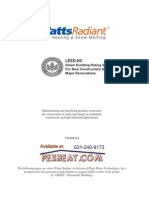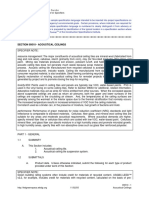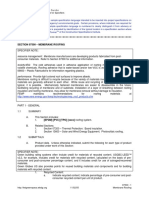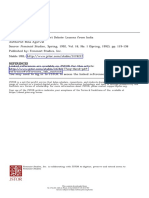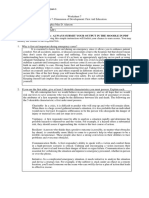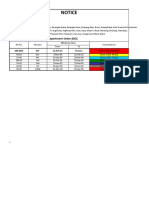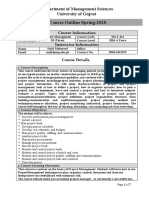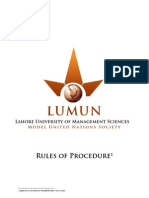Section 11450 - Residential Equipment: Whole Building Design Guide Federal Green Construction Guide For Specifiers
Section 11450 - Residential Equipment: Whole Building Design Guide Federal Green Construction Guide For Specifiers
Uploaded by
Anonymous NMytbMiDCopyright:
Available Formats
Section 11450 - Residential Equipment: Whole Building Design Guide Federal Green Construction Guide For Specifiers
Section 11450 - Residential Equipment: Whole Building Design Guide Federal Green Construction Guide For Specifiers
Uploaded by
Anonymous NMytbMiDOriginal Title
Copyright
Available Formats
Share this document
Did you find this document useful?
Is this content inappropriate?
Copyright:
Available Formats
Section 11450 - Residential Equipment: Whole Building Design Guide Federal Green Construction Guide For Specifiers
Section 11450 - Residential Equipment: Whole Building Design Guide Federal Green Construction Guide For Specifiers
Uploaded by
Anonymous NMytbMiDCopyright:
Available Formats
Whole Building Design Guide
Federal Green Construction Guide for Specifiers
This is a guidance document with sample specification language intended to be inserted into project specifications on
this subject as appropriate to the agency's environmental goals. Certain provisions, where indicated, are required for
U.S. federal agency projects. Sample specification language is numbered to clearly distinguish it from advisory or
discussion material. Each sample is preceded by identification of the typical location in a specification section where
TM
it would appear using the SectionFormat of the Construction Specifications Institute.
SECTION 11450 RESIDENTIAL EQUIPMENT
SPECIFIER NOTE:
resource management: Several green manufacturers produce super-efficient appliances and most
mainstream manufacturers now produce energy efficient models.
Some manufacturers have developed residential washers on the horizontal axis that require much less
water. When used in combination with ionizing washer disks, they can significantly reduced water usage
and pollution.
toxicity/IEQ: IAQ impact is comparable for green appliances and standard appliances. However, by
virtue of their improved energy efficiency, green appliances contribute far less contaminants to the
environment during their lifetime than due standard appliances.
performance: Obviously, energy efficient appliances require less energy to operate. Most perform the
task for which they were designed comparably to the standard designs which they replace. Federal Trade
Commission (FTC) regulations require appliances to be labeled indicating their energy performance (their
bright yellow EnergyGuide label).
Typically, horizontal axis washers are more efficient that top loading; and, top-bottom refrigerator/freezers
are more efficient than side-by-side refrigerators.
Recycling systems are available and include under-the-counter containers to separate recyclables. They
also include interior composting systems which are generally a variation of the standard garbage
disposal. In some designs, the composting chute empties to an externally accessible composting bin.
FEMP maintains product efficiency recommendations for a wide range of residential equipment including
appliances
and
mechanical
equipment;
refer
to
http://www.eere.energy.gov/femp/technologies/eep_eerecommendations.cfm
PART 1 - GENERAL
1.1
SUMMARY
A.
1.2
This Section includes:
1.
Refrigerators.
2.
Clothes Washers.
3.
Dishwashers.
4.
Freezers
SUBMITTALS
A.
Product data. Unless otherwise indicated, submit the following for each type of product
provided under work of this Section:
SPECIFIER NOTE:
Green building rating systems often include credit for materials of recycled content. USGBC-LEED
v2.2, for example, includes credit for materials with recycled content, calculated on the basis of pre-
http://fedgreenspecs.wbdg.org
11/02/05
11450 - 1
Residential Equipment
Whole Building Design Guide
Federal Green Construction Guide for Specifiers
consumer and post-consumer percentage content, and it includes credit for use of salvaged/recovered
materials.
Green Globes US also provides points for reused building materials and components and for building
materials with recycled content.
1.
Recycled Content:
a.
Indicate recycled content; indicate percentage of pre-consumer and postconsumer recycled content per unit of product.
b.
Indicate relative dollar value of recycled content product to total dollar
value of product included in project.
c.
If recycled content product is part of an assembly, indicate the
percentage of recycled content product in the assembly by weight.
d.
If recycled content product is part of an assembly, indicate relative dollar
value of recycled content product to total dollar value of assembly.
SPECIFIER NOTE:
Specifying local materials may help minimize transportation impacts; however it may not have a
significant impact on reducing the overall embodied energy of a building material because of efficiencies
of scale in some modes of transportation.
Green building rating systems frequently include credit for local materials. Transportation impacts
include: fossil fuel consumption, air pollution, and labor.
USGBC-LEED v2.2 includes credits for materials extracted/harvested and manufactured within a 500
mile radius from the project site. Green Globes US also provides points for materials that are locally
manufactured.
2.
Local/Regional Materials:
a.
Sourcing location(s): Indicate location of extraction, harvesting, and
recovery; indicate distance between extraction, harvesting, and recovery
and the project site.
b.
Manufacturing location(s): Indicate location of manufacturing facility;
indicate distance between manufacturing facility and the project site.
c.
Product Value: Indicate dollar value of product containing local/regional
materials; include materials cost only.
d.
Product Component(s) Value: Where product components are sourced
or manufactured in separate locations, provide location information for
each component. Indicate the percentage by weight of each component
per unit of product.
SPECIFIER NOTE:
USGBC-LEED v2.2 includes credit for water efficient landscaping and for water use reduction. Limiting
or eliminating the use of potable water for landscape irrigation can earn LEED credit. Reducing the
aggregate water use of the facility by minimum 20 percent from baseline (not including irrigation)
calculated as per the Energy Policy Act of 1992 fixture performance requirements contributes to LEED
credit.
3.
Water efficiency: Indicate water consumption rates in gallons per day (gpd) per
unit for the following:
a.
Clothes washers.
b.
Dishwashers.
SPECIFIER NOTE:
The EPA has developed minimum energy efficiency standards for Energy Star labeled products. EPA
Energy Star categories include: appliances, HVAC, residential equipment, office equipment, and lighting.
4.
Energy Efficiency:
a.
http://fedgreenspecs.wbdg.org
Submit documentation for Energy Star qualifications for equipment
provided under work of this Section.
11/02/05
11450 - 2
Residential Equipment
Whole Building Design Guide
Federal Green Construction Guide for Specifiers
B.
Submit environmental data in accordance with Table 1 of ASTM E2129 for products
provided under work of this Section.
SPECIFIER NOTE:
Identify special maintenance agreements. Maintenance agreements are standard practice in the building
industry. Take-back programs refer to programs in which the product manufacturer takes-back scrap
material and/or packaging associated with its product. Green leasing is a new, but dramatic shift in the
traditional perspective of leased equipment. Under a green lease, the product manufacturer is
responsible for the disposition of the product at all times. Thus, when the customer no longer requires the
use of the particular product or requires an updated model, the manufacturer is obligated to reclaim it and
refurbish it or disassemble it for recycling as appropriate. This approach necessitates a revision of
administrative services. It also requires a basic redesign of products in order to allow for future
disassembly and upgrade. This has the potential to be cost effective for manufacturers and customers
alike. It is also extremely resource efficient.
C.
Documentation of manufacturers [maintenance agreement] [take-back program]
[green lease] for each type of equipment. Include the following:
1.
Appropriate contact information.
2.
Overview of procedures.
a.
Indicate manufacturers commitment to reclaim materials for recycling
and/or reuse.
3.
Limitations and conditions, if any, applicable to the project.
1.3
MAINTENANCE
A.
Operational Service: Provide manufacturers [maintenance agreement] [take-back
program] [green lease] service for each type of equipment installed in project. Service
shall reclaim materials for recycling and/or reuse. Service shall not landfill or burn
reclaimed materials.
PART 2 - PRODUCTS
2.1
EQUIPMENT
A.
Refrigerator:
SPECIFIER NOTE:
Refrigerators: ENERGY STAR qualified models use at least 10 percent less energy than required by
current federal standards, and 40 percent less energy than the conventional models sold in 2001.
ENERGY STAR labeled commercial solid door refrigerators and freezers are up to 45 percent more
efficient than standard commercial refrigeration equipment.
1.
Energy Efficiency: Provide Energy Star labeled products.
B.
Clothes Washer:
SPECIFIER NOTE:
Clothes Washers: ENERGY STAR qualified washers use less water, which means less energy is needed
to heat it. Full-sized ENERGY STAR qualified washers use 18-25 gallons of water per load, compared to
the 40 gallons used by a standard machine.
1.
Energy Efficiency: Provide Energy Star labeled products.
2.
Water Efficiency: Provide Energy Star labeled products.
C.
Dishwasher:
SPECIFIER NOTE:
Dishwashers: ENERGY STAR qualified dishwashers use up to 25 percent less energy than the federal
minimum standard for energy consumption.
1.
Energy Efficiency: Provide Energy Star labeled products.
http://fedgreenspecs.wbdg.org
11/02/05
11450 - 3
Residential Equipment
Whole Building Design Guide
Federal Green Construction Guide for Specifiers
D.
Freezer:
SPECIFIER NOTE:
Freezers: ENERGY STAR qualified models use at least 10 percent less energy than required by current
federal standards, and 40 percent less energy than the conventional models sold in 2001. ENERGY
STAR labeled commercial solid door refrigerators and freezers are up to 45 percent more efficient than
standard commercial refrigeration equipment.
1.
Energy Efficiency: Provide Energy Star labeled products.
E.
Room Air Conditioner:
SPECIFIER NOTE:
Room Air Conditioners: ENERGY STAR qualified models use at least 10 percent less energy than
required by current federal standards.
1.
Energy Efficiency: Provide Energy Star labeled products.
PART 3 - EXECUTION
3.X
SITE ENVIRONMENTAL PROCEDURES
A.
Resource Management:
1.
Energy Efficiency: Verify equipment is properly installed, connected, and
adjusted. Verify that equipment is operating as specified.
2.
Coordinate with manufacturer for [maintenance agreement] [take-back
program] [green lease].
END OF SECTION
http://fedgreenspecs.wbdg.org
11/02/05
11450 - 4
Residential Equipment
You might also like
- 018113.14 FL - Sustainable Design Requirements - LEED v4 BD+CDocument9 pages018113.14 FL - Sustainable Design Requirements - LEED v4 BD+CAlbatool ElsayedNo ratings yet
- 1987 DBQDocument3 pages1987 DBQKamaraman TVe100% (2)
- Health 3 3rd Quarter FinalDocument54 pagesHealth 3 3rd Quarter Finalanon_3805127493% (30)
- Section 01830 - Operation and Maintenance: Whole Building Design Guide Federal Green Construction Guide For SpecifiersDocument3 pagesSection 01830 - Operation and Maintenance: Whole Building Design Guide Federal Green Construction Guide For SpecifiersAnonymous NMytbMiDNo ratings yet
- Section 08210 - Wood Doors: Whole Building Design Guide Federal Green Construction Guide For SpecifiersDocument5 pagesSection 08210 - Wood Doors: Whole Building Design Guide Federal Green Construction Guide For SpecifiersAnonymous NMytbMiDNo ratings yet
- 04-Communicative Competence and Analysis of Its ComponentsDocument10 pages04-Communicative Competence and Analysis of Its ComponentsJccd JccdNo ratings yet
- SPA SAmpleDocument15 pagesSPA SAmpleEmerson Biclar Golipardo100% (1)
- Resource Management:: Section 11680 - Office EquipmentDocument4 pagesResource Management:: Section 11680 - Office EquipmentAnonymous NMytbMiDNo ratings yet
- Section 16500 - Lighting: Whole Building Design Guide Federal Green Construction Guide For SpecifiersDocument8 pagesSection 16500 - Lighting: Whole Building Design Guide Federal Green Construction Guide For SpecifiersAnonymous NMytbMiDNo ratings yet
- Section 15700 - Heating, Ventilating, & Air Conditioning EquipmentDocument7 pagesSection 15700 - Heating, Ventilating, & Air Conditioning EquipmentAnonymous NMytbMiDNo ratings yet
- Resource Management: toxicity/IEQ:: Section 15800 - Air DistributionDocument5 pagesResource Management: toxicity/IEQ:: Section 15800 - Air DistributionAnonymous NMytbMiDNo ratings yet
- Section 09720 - Wallcovering: Whole Building Design Guide Federal Green Construction Guide For SpecifiersDocument4 pagesSection 09720 - Wallcovering: Whole Building Design Guide Federal Green Construction Guide For SpecifiersAnonymous NMytbMiDNo ratings yet
- Section 09654 - Linoleum: Whole Building Design Guide Federal Green Construction Guide For SpecifiersDocument6 pagesSection 09654 - Linoleum: Whole Building Design Guide Federal Green Construction Guide For SpecifiersAnonymous NMytbMiDNo ratings yet
- Resource Management:: Section 07900 - Joint SealantsDocument3 pagesResource Management:: Section 07900 - Joint SealantsAnonymous NMytbMiDNo ratings yet
- Section 09250 - Gypsum Board: Whole Building Design Guide Federal Green Construction Guide For SpecifiersDocument3 pagesSection 09250 - Gypsum Board: Whole Building Design Guide Federal Green Construction Guide For SpecifiersAnonymous NMytbMiDNo ratings yet
- Watts Radiant LEED-NC Green Building ApplicationsDocument13 pagesWatts Radiant LEED-NC Green Building ApplicationsBrian WhitehurstNo ratings yet
- SECTION 01 81 13 Sustainable Construction Requirements Part 1 - General 1.1 DescriptionDocument18 pagesSECTION 01 81 13 Sustainable Construction Requirements Part 1 - General 1.1 DescriptionJuanPaoloYbañezNo ratings yet
- Section 32 90 00 (Section 02900) - PlantingDocument12 pagesSection 32 90 00 (Section 02900) - PlantingdfdNo ratings yet
- Section 08500 - Windows: Whole Building Design Guide Federal Green Construction Guide For SpecifiersDocument7 pagesSection 08500 - Windows: Whole Building Design Guide Federal Green Construction Guide For SpecifiersAnonymous NMytbMiDNo ratings yet
- Resource Management: toxicity/IEQ: Performance:: Section 10170 - Plastic Toilet CompartmentsDocument5 pagesResource Management: toxicity/IEQ: Performance:: Section 10170 - Plastic Toilet CompartmentsAnonymous NMytbMiDNo ratings yet
- Fgs 313100Document6 pagesFgs 313100Lionel Carel Tchiendjo TchanagNo ratings yet
- Section 09510 - Acoustical Ceilings: Whole Building Design Guide Federal Green Construction Guide For SpecifiersDocument5 pagesSection 09510 - Acoustical Ceilings: Whole Building Design Guide Federal Green Construction Guide For SpecifiersAnonymous NMytbMiDNo ratings yet
- Section 07500 - Membrane Roofing: Whole Building Design Guide Federal Green Construction Guide For SpecifiersDocument5 pagesSection 07500 - Membrane Roofing: Whole Building Design Guide Federal Green Construction Guide For SpecifiersAnonymous NMytbMiDNo ratings yet
- CALGreen Non-Residential Comparison To LEED For Building Design & ConstructionDocument7 pagesCALGreen Non-Residential Comparison To LEED For Building Design & ConstructionBerkeley AnalyticalNo ratings yet
- Section 15400 - Plumbing Fixtures and EquipmentDocument4 pagesSection 15400 - Plumbing Fixtures and EquipmentAnonymous NMytbMiDNo ratings yet
- Section 04200 - Masonry: Whole Building Design Guide Federal Green Construction Guide For SpecifiersDocument4 pagesSection 04200 - Masonry: Whole Building Design Guide Federal Green Construction Guide For SpecifiersAnonymous NMytbMiDNo ratings yet
- Sample LEED PlanDocument36 pagesSample LEED Planskip_16157No ratings yet
- Sustainable Design Requirements - LEEDDocument8 pagesSustainable Design Requirements - LEEDasgharNo ratings yet
- Section 02795 Porous Paving: Whole Building Design Guide Federal Green Construction Guide For SpecifiersDocument6 pagesSection 02795 Porous Paving: Whole Building Design Guide Federal Green Construction Guide For SpecifiersAnonymous NMytbMiDNo ratings yet
- SITES SpecificationsDocument10 pagesSITES Specificationsbhughes6768No ratings yet
- Module 1 - Green Buildings in ContextDocument9 pagesModule 1 - Green Buildings in ContextĐặng Gia HoàngNo ratings yet
- SECTION 09650 Resilient Flooring: Whole Building Design Guide Federal Green Construction Guide For SpecifiersDocument5 pagesSECTION 09650 Resilient Flooring: Whole Building Design Guide Federal Green Construction Guide For SpecifiersAnonymous NMytbMiDNo ratings yet
- Sustainable Building MaterialsDocument13 pagesSustainable Building Materialssmishra2222No ratings yet
- Sustainability Handbook - EnglishDocument43 pagesSustainability Handbook - EnglishMoataz MahmoudNo ratings yet
- Energy A. Energy EfficiencyDocument16 pagesEnergy A. Energy EfficiencyShahed HussainNo ratings yet
- Activity2 3 2greenbuildingandsustainabledesignDocument2 pagesActivity2 3 2greenbuildingandsustainabledesignapi-302019372No ratings yet
- 018113-Sustainable Design requirements-LEEDv4Document15 pages018113-Sustainable Design requirements-LEEDv4SharmilaNo ratings yet
- Leed Practise Exams - Pool FDocument43 pagesLeed Practise Exams - Pool FTabish SuhailNo ratings yet
- Lighting Criteria StandardsDocument19 pagesLighting Criteria Standards18926119No ratings yet
- PSC Manual - Product and Service Codes Manual - Final - 11 August 2011Document328 pagesPSC Manual - Product and Service Codes Manual - Final - 11 August 2011SorinNo ratings yet
- Daikin's PolicyDocument8 pagesDaikin's Policyhvactrg1No ratings yet
- Research and Development Roadmap For Next-Generation AppliancesDocument75 pagesResearch and Development Roadmap For Next-Generation Appliancesjmertes100% (1)
- Estidama Compliance Handbook Opt Tcm8-12519Document11 pagesEstidama Compliance Handbook Opt Tcm8-12519Rawan Alwan ZarifNo ratings yet
- R08-He2se Hotel2-Keo-Spc-Su-00Document46 pagesR08-He2se Hotel2-Keo-Spc-Su-00moh amohNo ratings yet
- Section 06700 - Alternative Agricultural ProductsDocument6 pagesSection 06700 - Alternative Agricultural ProductsAnonymous NMytbMiDNo ratings yet
- Leed Application Guide: Melink Corporation, 5140 River Valley Road, Milford, OH 45150Document14 pagesLeed Application Guide: Melink Corporation, 5140 River Valley Road, Milford, OH 45150M A MunimNo ratings yet
- Section 12700 - Systems Furniture: Whole Building Design Guide Federal Green Construction Guide For SpecifiersDocument11 pagesSection 12700 - Systems Furniture: Whole Building Design Guide Federal Green Construction Guide For SpecifiersAnonymous NMytbMiDNo ratings yet
- The Economic Benefits of Sustainable Design: Lower (Or Equal) First CostsDocument34 pagesThe Economic Benefits of Sustainable Design: Lower (Or Equal) First CostsAmal76No ratings yet
- LEED Cover Letter For BID PKGDocument2 pagesLEED Cover Letter For BID PKGIlde Brando Leoncito AdarloNo ratings yet
- Greenstep - Answers To 25 Question LEED Green Associate Practice ExamDocument2 pagesGreenstep - Answers To 25 Question LEED Green Associate Practice ExamjacksonliNo ratings yet
- Building Energy CodesDocument212 pagesBuilding Energy CodesBudega100% (1)
- Appendix 1 - Manufacturing Sector KGFTDocument24 pagesAppendix 1 - Manufacturing Sector KGFTmaxwell kahindiNo ratings yet
- Zurn LEED Credit Guide Aug09Document18 pagesZurn LEED Credit Guide Aug09Alejandro SasmayNo ratings yet
- Resource Management:: Section 02220 - Site DemolitionDocument2 pagesResource Management:: Section 02220 - Site DemolitionAnonymous NMytbMiDNo ratings yet
- Section 02872 - Bat House: Whole Building Design Guide Federal Green Construction Guide For SpecifiersDocument4 pagesSection 02872 - Bat House: Whole Building Design Guide Federal Green Construction Guide For SpecifiersAnonymous NMytbMiDNo ratings yet
- 221 1 Engineering Work Suwpport by Excel Based ProgramDocument1 page221 1 Engineering Work Suwpport by Excel Based ProgramZoebairNo ratings yet
- Can Filter Selection Reduce HVAC Energy Costs?Document3 pagesCan Filter Selection Reduce HVAC Energy Costs?Joshua D'CruzNo ratings yet
- GrasimDocument10 pagesGrasimGaurav SinghNo ratings yet
- Zero Footprint Design For Urban DevelopmentDocument14 pagesZero Footprint Design For Urban DevelopmentJohn Olaf NelsonNo ratings yet
- Gs 31Document8 pagesGs 31kennyarthurNo ratings yet
- PNNL 19809Document145 pagesPNNL 19809garycwkNo ratings yet
- Retrofit - A Viable Alternative To Greenfield ConstructionDocument4 pagesRetrofit - A Viable Alternative To Greenfield ConstructionNAMONo ratings yet
- DEER User's GuideDocument21 pagesDEER User's GuideAnonymous NMytbMiDNo ratings yet
- SECTION 09650 Resilient Flooring: Whole Building Design Guide Federal Green Construction Guide For SpecifiersDocument5 pagesSECTION 09650 Resilient Flooring: Whole Building Design Guide Federal Green Construction Guide For SpecifiersAnonymous NMytbMiDNo ratings yet
- Section 09654 - Linoleum: Whole Building Design Guide Federal Green Construction Guide For SpecifiersDocument6 pagesSection 09654 - Linoleum: Whole Building Design Guide Federal Green Construction Guide For SpecifiersAnonymous NMytbMiDNo ratings yet
- Section 08500 - Windows: Whole Building Design Guide Federal Green Construction Guide For SpecifiersDocument7 pagesSection 08500 - Windows: Whole Building Design Guide Federal Green Construction Guide For SpecifiersAnonymous NMytbMiDNo ratings yet
- Section 09250 - Gypsum Board: Whole Building Design Guide Federal Green Construction Guide For SpecifiersDocument3 pagesSection 09250 - Gypsum Board: Whole Building Design Guide Federal Green Construction Guide For SpecifiersAnonymous NMytbMiDNo ratings yet
- Section 07500 - Membrane Roofing: Whole Building Design Guide Federal Green Construction Guide For SpecifiersDocument5 pagesSection 07500 - Membrane Roofing: Whole Building Design Guide Federal Green Construction Guide For SpecifiersAnonymous NMytbMiDNo ratings yet
- Section 12700 - Systems Furniture: Whole Building Design Guide Federal Green Construction Guide For SpecifiersDocument11 pagesSection 12700 - Systems Furniture: Whole Building Design Guide Federal Green Construction Guide For SpecifiersAnonymous NMytbMiDNo ratings yet
- Resource Management: toxicity/IEQ: Performance:: Section 10170 - Plastic Toilet CompartmentsDocument5 pagesResource Management: toxicity/IEQ: Performance:: Section 10170 - Plastic Toilet CompartmentsAnonymous NMytbMiDNo ratings yet
- Section 09510 - Acoustical Ceilings: Whole Building Design Guide Federal Green Construction Guide For SpecifiersDocument5 pagesSection 09510 - Acoustical Ceilings: Whole Building Design Guide Federal Green Construction Guide For SpecifiersAnonymous NMytbMiDNo ratings yet
- Section 03300 - Cast-In-Place Concrete: Whole Building Design Guide Federal Green Construction Guide For SpecifiersDocument7 pagesSection 03300 - Cast-In-Place Concrete: Whole Building Design Guide Federal Green Construction Guide For SpecifiersAnonymous NMytbMiDNo ratings yet
- Glass and EnergyDocument57 pagesGlass and EnergyAnonymous NMytbMiDNo ratings yet
- Canadian Jeweller Magazine November 2009Document88 pagesCanadian Jeweller Magazine November 2009rivegaucheNo ratings yet
- DLP in 21st Century LiteratureDocument2 pagesDLP in 21st Century LiteratureJohn Renz BermudezNo ratings yet
- Counseling PhilosophyDocument7 pagesCounseling Philosophyapi-403911586No ratings yet
- Ambulant RepublicDocument52 pagesAmbulant RepublicRamon MartinezNo ratings yet
- Business Analysis Fundamentals BACCM PDFDocument8 pagesBusiness Analysis Fundamentals BACCM PDFskumaritesNo ratings yet
- 1 GEN ED PRE BOARD Rabies Comes From Dog and Other BitesDocument12 pages1 GEN ED PRE BOARD Rabies Comes From Dog and Other BitesJammie Aure EsguerraNo ratings yet
- "FORM 2" (See Rule 10) Form of Application For The Grant of Learner'S LicenceDocument3 pages"FORM 2" (See Rule 10) Form of Application For The Grant of Learner'S Licencefida mohammadNo ratings yet
- Lucio Tan FinalDocument39 pagesLucio Tan FinalKyaw TheikNo ratings yet
- Bina AgarwalDocument41 pagesBina AgarwalProbablyNo ratings yet
- EEM4 Field Activation ProcedureDocument3 pagesEEM4 Field Activation ProcedureMihai PopescuNo ratings yet
- Youth Radicalization in Punjab, PakistanDocument25 pagesYouth Radicalization in Punjab, PakistanRaheem Ul HaqueNo ratings yet
- How To Build A 6 Month USMLE Step 1 Study ScheduleDocument5 pagesHow To Build A 6 Month USMLE Step 1 Study ScheduleabdulwahabNo ratings yet
- Lesson 2 Receptive CommunicationDocument18 pagesLesson 2 Receptive CommunicationNathaniel CataquisNo ratings yet
- Forced Migration Case StudyDocument49 pagesForced Migration Case StudyshradhaNo ratings yet
- Numbers in Serbian: Listen To The Free Audio Recordings Download Our Free Language Learning E-BookDocument4 pagesNumbers in Serbian: Listen To The Free Audio Recordings Download Our Free Language Learning E-BookAltammar13No ratings yet
- NSTP Worksheet 7Document2 pagesNSTP Worksheet 7Sophia AlarconNo ratings yet
- Callahan 2017, Lumyo in The 2014 CensusDocument28 pagesCallahan 2017, Lumyo in The 2014 CensusschissmjNo ratings yet
- Academic Excellence AwardDocument6 pagesAcademic Excellence Awardrhea glipoNo ratings yet
- RDO No. 41 - MandaluyongDocument183 pagesRDO No. 41 - MandaluyongDonnaManlangitNo ratings yet
- Course Outline Spring-2020: Department of Management Sciences University of GujratDocument7 pagesCourse Outline Spring-2020: Department of Management Sciences University of Gujrat17460920-076No ratings yet
- Integrated Group ProjectDocument15 pagesIntegrated Group Projectmduduzi siphesihle sitholeNo ratings yet
- Clorox Case StudyDocument2 pagesClorox Case StudyRohan GuptaNo ratings yet
- Cpdprogram Crim 092619Document36 pagesCpdprogram Crim 092619SEUNGWANderingNo ratings yet
- Douglas Adams & John Lloyd - The Deeper Meaning of LiffDocument60 pagesDouglas Adams & John Lloyd - The Deeper Meaning of Liffdoes_not_existNo ratings yet
- LUMUN - Rules of ProcedureDocument18 pagesLUMUN - Rules of ProcedureMehrwar IsmailNo ratings yet
- Technical Paper QuestionnaireDocument5 pagesTechnical Paper QuestionnaireAngel LyricsNo ratings yet















